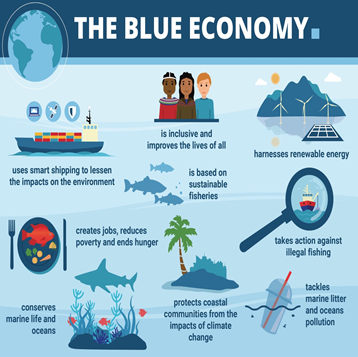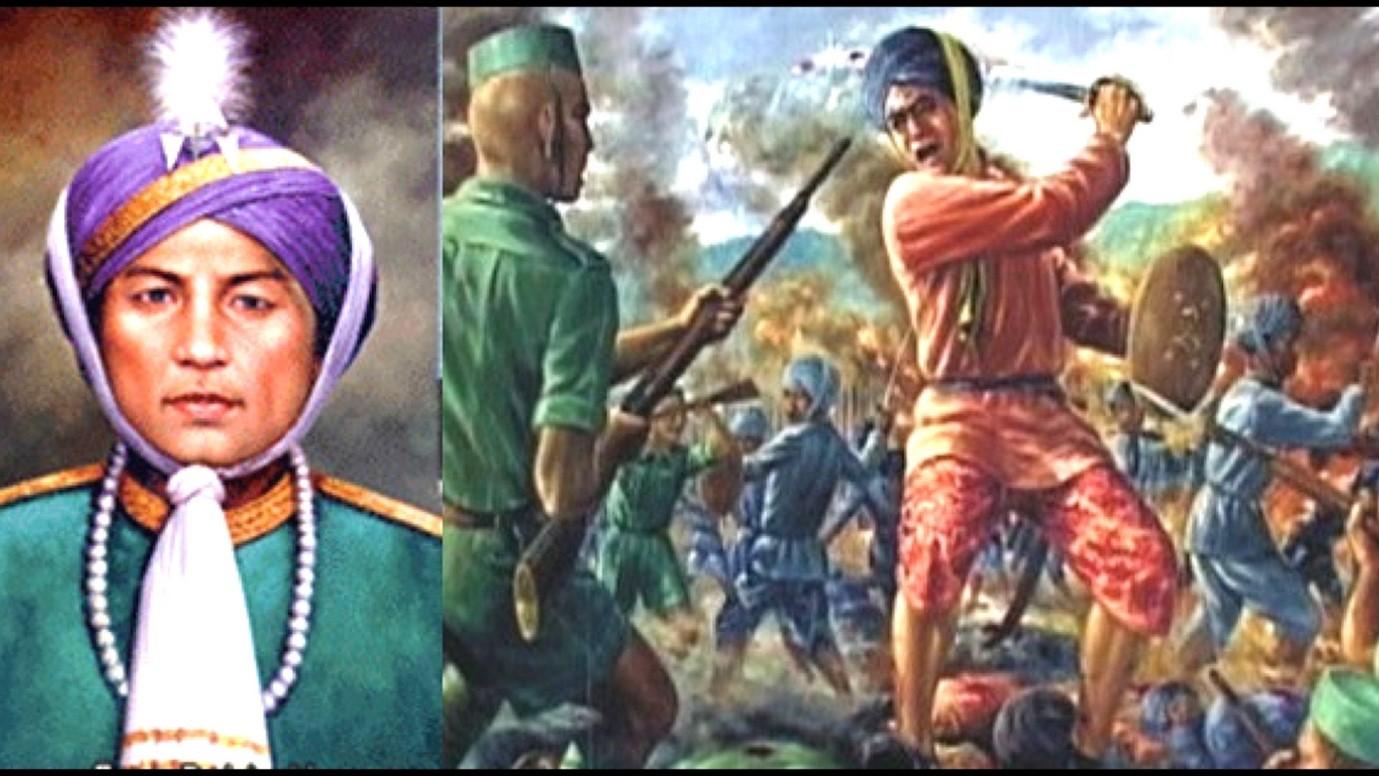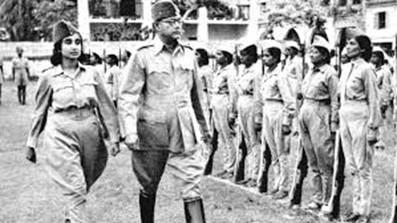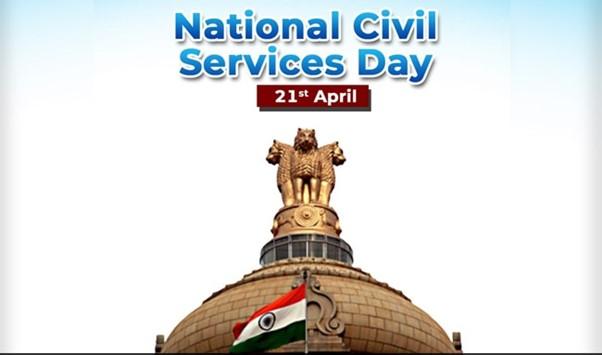Tuesday, 27th April 2021
India third highest military spender in 2020
In News
India is the third highest military spender in 2020, as per the data published by Stockholm International Peace Research Institute (SIPRI).
About the News
- According to SIPRI, which tracks military expenditure and arms trade globally, the US accounted for 39 per cent of the money spent on military globally, China accounted for 13 per cent, and India accounted for 7 per cent of the globe’s share.
- Military expenditure refers to all government spending on current military forces and activities, including salaries and benefits, operational expenses, arms and equipment purchases, military construction, research and development, and central administration, command and support.
- All three countries saw their military spending go up compared to 2019, even during a pandemic year.
- The United States’ military spending was 3.7 per cent of its GDP while the corresponding numbers for China and India were 1.7 per cent and 9 per cent respectively.
- As a result, military spending as a share of GDP reached a global average of 2.4 per cent in 2020, up from 2.2 per cent in 2019, the biggest year-on-year rise in the military burden since the global financial and economic crisis in 2009.
- As per SIPRI, the military spending in Asia and Oceania continued with an uninterrupted upward trend since at least 1989 and it can be attributed primarily to increases in spending by China and India, which together accounted for 62 per cent of total military expenditure in the region in 2020.
About India’s Military Spending
- India’s annual military expenditure also includes a huge pension In the 2021-2022 defence budget, for instance, the pension bill was Rs 1.15 lakh crore out of the total Rs 4.78 lakh crore outlay.
- India also has to maintain an over 15-lakh strong armed forces because of the two active and unresolved borders with China and Pakistan. Consequently, the revenue expenditure for the day-to-day running costs and salary bill in the defence budget by far outstrips the capital outlay for military modernisation, leaving critical operational shortages on different fronts, ranging from fighters to submarines.
- The continuing military confrontation with China in eastern Ladakh has led India to make several emergency arms purchases from abroad since the crisis erupted in early-May last year.
- With a weak domestic defence-industrial base, India continues to languish in the strategically-vulnerable position of being the world’s second-largest arms importer just behind Saudi Arabia. India accounted for 5% of the total global arms imports during 2016-2020.
Sources: https://sipri.org/media/press-release/2021/world-military-spending-rises-almost-2-trillion-2020
RBI extends Ways and Means credit for States, UTs to September
In News
Given the prevalence of COVID-19, the Reserve Bank of India (RBI) has decided to continue with the existing interim Ways and Means Advances (WMA) scheme limit for all States/ UTs for six months.
About Ways and Means Advances (WMA)
- Introduced in 1997, it is a facility for both the Centre and states to borrow from the RBI.
- WMA funding is much cheaper than borrowings from markets and it is meant purely to help the government tide over temporary mismatches in cash flows of their receipts and expenditures.
- The interest rate on WMA is the RBI’s repo rate, which is basically the rate at which it lends short-term money to banks (currently 4.4%).
- The governments are also allowed to draw amounts in excess of their WMA limits. The interest on such overdraft is 2 percentage points above the repo rate.
- There aretwo types of Ways and Means Advances for State Governments:
- Special WMA/Special Drawing Facility (SDF): Theinterest rate for Special WMA is one percentage point less than the repo rate. After the state has exhausted the limit of Special WMA, it gets normal WMA.
- Normal WMA: The loans under normal WMAis based on a three-year average of actual revenue and capital expenditure of the state.
What are the existing WMA limits and overdraft conditions and what is its significance?
- For the Centre, the WMA limit during April-September 2020-21 has been fixed at Rs 120,000 crore which is 60% higher than the 2019-20 limit. For the states, the aggregate WMA limit was Rs 32,225 crore till March 2020 which has been hiked to 60 % for this period.
- These relaxations have been made as government finances are in a mess lately owing to the lockdown that has resulted in revenues drying up.
- Conversely, the states are incurring the bulk of the on-the-ground expenditures for combating the novel coronavirus.
- State Governments can avail of Special Drawing Facility (SDF) from the Reserve Bank against the collateral of the funds in Auction Treasury Bills (ATB), Consolidated Sinking Fund (CSF) and Guarantee Redemption Fund (GRF). State Governments maintain CSF and GRF with the Reserve Bank as buffers for repayment of their liabilities.
|
Auction Treasury Bills: · These are money market instruments issued by the Government of India as a promissory note with guaranteed repayment at a later date. Funds collected are used to meet short term requirements of the government, aiming to reduce the fiscal deficit of a country. Consolidated Sinking Fund: · To meet redemption of market loans of the states, CSF was set up by RBI in 1999-2000. · This fund is utilized for amortization of all loans, including loans from banks, liabilities on account of National Small Saving Fund (NSSF), etc. Guarantee Redemption Fund: · GRF was established in 1999-2000 for redemption of guarantees given to Central Public Sector Enterprises, Financial Institutions, etc. by the Union Government whenever such guarantees are invoked. |
Primary Source: https://indianexpress.com/article/explained/reserve-bank-of-india-rbi-ways-and-means-advances-wma-repo-rate-coronavirus-covid-19-6367396/
Government to transform Traditional Organic Areas into organic hubs
In News
The Department of Agriculture, Cooperation and Farmers Welfare is working to identify Traditional Organic Areas to transform them into certified organic production hubs under the Large Area Certification Scheme.
Highlights of the initiative
- Area identified in Andaman and Nicobar Island: Car Nicobar and Nancowry group of islands of Andaman & Nicobar Islands becomes the first large contiguous territory to be conferred with organic certification under the ‘Large Area Certification’ (LAC) scheme.
- Other areas identified: Agriculture areas in states like Himachal, Uttarakhand, North Eastern states and tribal belts of Jharkhand and Chhattisgarh, desert districts of Rajasthan which are essentially free from the use of chemical inputs can be transformed to certified organic hubs. UTs of Lakshadweep and Ladakh are proactively taking steps for the same.
- Development of Niche Products: to facilitate the marketing of area-specific niche products through branding and labelling.
About Large Area Certification Scheme
- It is an organic certification programme undertaken under PGS-India (Participatory Guarantee System) programme for large clusters.
- Under LAC, each village in the area is considered as one cluster/group. All farmers with their farmland and livestock need to adhere to the standard requirements and on being verified get certified enmass without the need to go under conversion period.
- Some Criteria for Large Area Certification - Administrative ban on use, sale and supply of GMO seeds, synthetic agro inputs in the defined area.
Significance of Large Area Certification Scheme
- Benefit hill areas and tribal districts: There are large contiguous areas in hills, tribal districts, desert and rained areas in India that continue to remain free from chemical input usage and can be immediately brought under organic certification.
- Quicker and cost effective: As per the established norm of organic production systems, the areas having chemical input usage history are required to undergo a transition period of minimum 2-3 years to qualify as organic. Large Area Certification is a cost-effective process and farmers do not have to wait for 2-3 years for marketing organic certified products.
- Augmenting organic farming in India: The LAC programme will support other government schemes to promote organic farming like the Paramparagat Krishi Vikas Yojana, Organic Mission in North East, etc. India now has more than 30 lakh hectare area registered under organic certification.
Source -https://pib.gov.in/PressReleasePage.aspx?PRID=1714281
Groundwater Depletion and Cropping Intensity
In News
A recent study has found that Groundwater depletion may reduce winter cropping intensity by 20% in India
Findings of the Study
- The study was conducted with satellite and census data from India to quantify the impacts of groundwater depletion on cropping intensity.
- The study notes that with severe groundwater depletion, the cropping intensity or the amount of land planted in the winter season may decrease by up to 20% by 2025. Some of the important winter crops are wheat, barley, mustard and peas.
- The team also studied India’s three main irrigation types on winter cropped areas: dug wells, tube wells, canals, and also analysed the groundwater data from the Central Ground Water Board.
- They found that 13% of the villages in which farmers plant a winter crop are located in critically water-depleted regions.
- These villages may lose 68% of their cropped area in future if access to all groundwater irrigation is lost. The results suggest that these losses will largely occur in northwest and central India.
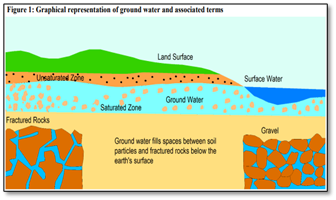
What is Groundwater and why is it so crucial for irrigation in India?
- Ground water is the water that seeps through rocks and soil and is stored below the ground. The rocks in which ground water is stored are called aquifers.
- India is the largest groundwater user in the world, according to the World Bank, using nearly a quarter of the global total. This is partly because of decentralised access to water in the country.
- 89% of ground water extracted is used in the irrigation sector, followed by domestic use which is 9% of the extracted groundwater. Industrial use of ground water is 2%.
- Wells, including dug wells, shallow tube-wells and deep tube wells provide about 61.6% of water for irrigation, followed by canals with 24.5%.
What are the reasons for accelerated depletion of Groundwater?
- Intensive agriculture: In the green revolution era, policy-supported environment led to a large increase in rice cultivation in north- western India mainly in Punjab and Haryana which are ecologically less suitable for rice cultivation due to predominantly light soils.
- This policy-supported intensive agriculture led to unsustainable groundwater use for irrigation and in turn groundwater scarcity.
- Recharge Problem: Weak monsoons due to climate change have further eroded India’s groundwater reserves. Groundwater mainly depends on rainfall for recharge, so deficient rains mean less groundwater availability. A failed monsoon leads farmers to draw deeper from groundwater to irrigate their crops, which pushes water tables down further.
- Groundwater not prioritised in policies: Groundwater is invisible, not visible to the eye because it is well below the ground. Also, Water falls under the State List and thus the usage are prioritised as per the State’s needs, losing the sight of overall national problem. This leads to complexities in forming in one law and strict adherence to it.
- Estimation of ground water resources: The current assessment methodology is indicative and not representative. So there is need for a clearer understanding of the state of aquifers in India for their management and governance at the local level.
- Agricultural crop pricing and water intensive crops: Decisions such as cropping pattern and cropping intensity are taken independent of the ground water availability in most areas.
- Example: Though Minimum Support Prices (MSPs) are currently announced for many other crops crops, the effective price support is for wheat and rice. This creates highly skewed incentive structures in favour of wheat and paddy, which are water intensive crops and depend heavily on ground water for their growth.
- Energy subsidies and ground water extraction: Since power is a main component of the cost of ground water extraction, the availability of cheap/subsidised power in many states adds to the greater extraction of this resource. Moreover, electricity supply is not metered and a flat tariff is charged depending on the horsepower of the pump.
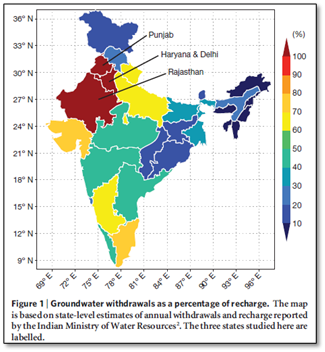
Possible solutions to the problem
- Database on natural and artificial recharge of water: A single agency can be formed to maintain a database on (i) the amount of ground water being utilised by various stakeholders, and (ii) natural and artificial recharge to ground water.
- Study of Dark Blocks: A study to assess land-use and proportion of agricultural land falling under dark blocks (over-exploited assessment units) can be initiated. This will help determine suitable cropping pattern in areas that are water stressed. Additionally, an impact study to determine losses caused to economy, health and environment due to dark blocks should be carried out.
- Policy level changes: Policies that reduce the demand for groundwater, such as switching to less water-intensive cereals, could be one way to reduce pressures on existing groundwater reserves.
- For instance, policies that promote increased field-level water use efficiency, such as the adoption of water-saving technologies like sprinkler and drip irrigation should be prioritised.
- Development in groundwater rich states: Studies have suggested that eastern India (i.e., Bihar, Jharkhand, Odisha, and West Bengal) may be able to become the future bread basket of India as groundwater in this region has not been overexploited, and tube well infrastructure can be further developed. This required heavy investment in groundwater infrastructure.
Sources: https://advances.sciencemag.org/content/7/9/eabd2849
https://www.downtoearth.org.in/blog/water/depleting-groundwater-costs-farmers-heavily-65530
This day in History- Freedom Day in South Africa

On 27 April, 1994 South Africa’s first all-race elections were held. This day is celebrated as Freedom Day in South Africa. It is significant because it marks the end of over three hundred years of colonialism, segregation and white minority rule, and establishment of a new democratic government led by Nelson Mandela. The holding of the first non-racial elections was the culmination of years of struggle and led to the release of political prisoners and formal all-party negotiations which drafted an interim constitution.
Image of the Day- Huo-Yan Air Lab
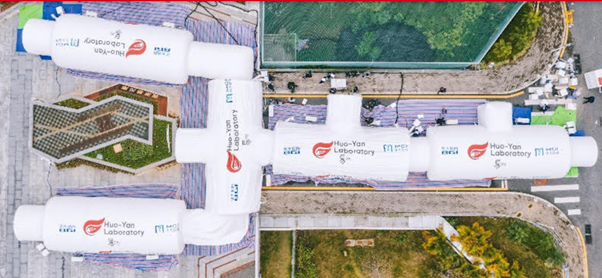
The first Huo-Yan Air Lab, an inflatable, portable laboratory equipped with a medical waste exhaust system, qPCR instruments, gene sequencers, and other COVID-19 nucleic acid detection technology, was installed outside the China National Gene Bank in Shenzhen in April, 2021. The easily transportable structure is intended to help ramp up virus testing and screening infrastructure. Covering an area of roughly 400 square meters, the facility can process 5,000 to 10,000 samples per day.
Section 144 of the Code of Criminal Procedure (CrPC)
- Context: Owing to the rising number of Covid-19 cases, section 144 (CrPC)imposed in Gurugram, other important cities.
- Enacted in 1973, this law empowers the magistrate of any state or union territory in India to pass an order prohibiting the gathering of five or more people in a specified area.
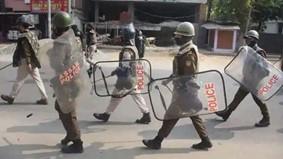
- The ultimate purpose of Section 144 is to maintain peace and orderin the areas where trouble could erupt to disrupt regular life.
- There shall be no public movement and complete bar on holding any kind of public meetings or rallies. It is deemed a punishable offence to obstruct law enforcement agenciesfrom disbanding an unlawful assembly.
- It also empowers the authorities to block internet access in the region.
- No order under this section can remain in force for a period of more than 2 months and the state government can choose to extend the validity for two more months with the maximum validity extendable to six months.
#FOSS4GOV Innovation Challenge
- Context: TheMinistry of Electronics & IT (MeitY) has announced #FOSS4GOV Innovation Challenge to accelerate adoption of Free and Open-Source Software (FOSS) in government.
- With an aim to harness the innovation potential tech start-ups to solve critical issues in GovTech, #FOSS4GOV Innovation Challenge calls upon innovators, entrepreneurs, and Indian Startups to submit implementable open-source product innovations in CRM (Customer Relationship Management) and ERP (Enterprise Resource Planning) with applications for Govtech in Health, Education, Agriculture, Urban Governance, etc.
|
Free and Open-Source Software (FOSS) · The term open source refers to something people can inspect, modify, enhance, and share because its design is publicly accessible. · The term “free” indicates that the software does not have constraints on copyrights. It does not mean the software is free of cost. · Examples- Linux etc.
Govtech · Gov Tech is India's forum for excellence in innovation and government service delivery. It is a platform to showcase major technology solutions and an awards program that celebrates such excellence and achievements across all levels of government in India. |
Primary source: https://pib.gov.in/PressReleseDetailm.aspx?PRID=1713452
Mahavir Jayanti
- Context: Yearly Mahavir Jayanti celebrations.
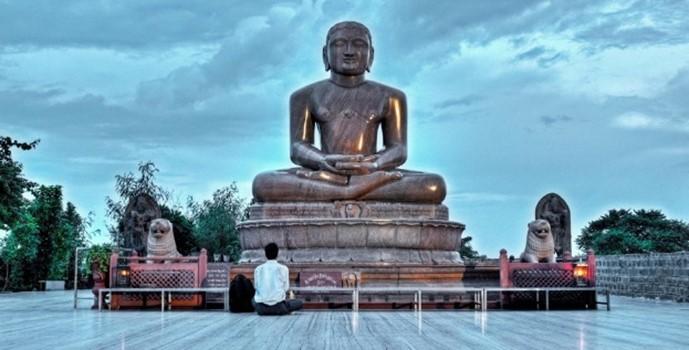
- Lord Mahavir was the 24thand the last Tirthankara (spiritual teacher of Jainism) who succeeded the 23rd Tirthankara, Parshvanatha.
- On this day, a procession is called with the idol of Lord Mahavira called the Rath Yatra. Reciting stavans (Jain prayers), statues of the lord are given a ceremonial bath called Abhisheka.
|
About Lord Mahavira · Lord Mahavira, the founder of Jainism, was born in 599 BC in a royal family of Ikshvaku dynasty in Vajji kingdom (modern day Vaishali in Bihar). · In constant search of inner peace and spirituality, he renounced the throne and his family to seek spiritual truth. He led a life of an ascetic and extreme penance and profound austerity before attaining 'Kevala Jnana' or omniscience. · According to Mahavira, to live a righteous life one should follow the 5 principles of non-violence (Ahimsa), truthfulness (Satya), non-stealing (Asteya), chastity (Bramacharya) and non-attachment (Aparigraha). |
Primary source: https://www.indiatoday.in/information/story/mahavir-jayanti-2021-date-history-significance-and-all-you-need-to-know-1794767-2021-04-25
An idea on taxation that is worth a try – The Hindu
Essence - United States Secretary of the Treasury Janet L. Yellen has proposed a global minimum tax rate. If the major world economies agree and the U.S. Congress approves the increased tax rates, it would constitute a reversal of the trend in tax policies since the collapse of the Soviet Bloc 30 years back. Against this background, this article analyses the need and implications of a global minimum tax rate regime.
Why you should read this article?
- Understand the compulsions and reasons for a cut in tax rates globally since the collapse of the Soviet Bloc.
- Know about the need for increase in direct tax rate such as massive budget deficits, increased public spending, regressive tax structure and rising inequalities among others.
- Comprehend that why coordination is required at global level to have a minimum tax rate.
Link - https://www.thehindu.com/opinion/op-ed/an-idea-on-taxation-that-is-worth-a-try/article34417756.ece
India must bridge the gender parity gap – Hindu Business Line
Essence- This editorial is written in backdrop of slip in Gender Gap ranking of India under WEF Global Gender Gap Report 2021 (labour participation of women is 22 percent, one of the lowest in the world). India suffered mainly in political empowerment and economic participation. But If these challenges tackled through educational attainment and economic participation, political empowerment, recognition to the informal and vulnerable sections of the labour market etc., the global GDP could rise by as much as $ 28 trillion by 2025. We need to be more focused on execution of part whether it is any scheme, bill or a programme. Where CEO of the enterprises has great onus of driving gender equality by embracing the government initiatives by; EMBRACING policies for inclusion of women; CHANNELISING the CSR fund more strategically towards localized women growth and development; INFLUENCING policy makers for gender equality policies.
Why you should read this article?
- To know the factors responsible for slip in gender gap and understand why filling this gender gap is significant for India and the world.
- To know what could be the possible solutions to tackle these challenges.
- To understand how enterprises has role to play in squeezing the gender gap in India.
Pratibha Parv: Strengthening quality of education in government schools of Madhya Pradesh
Present Situation
- There are various issues in education facility provided in the government schools like lack of infrastructural facilities, shortage of well-trained and motivated teachers, High rate of teacher absenteeism, increased drop-out rates and under-staffed government schools which adversely affect the quality of education.
- Pratibha Parv Initiative in Madhya Pradesh evolved as a response to these education issues.
About Pratibha Parv Initiative
- Pratibha Parv, literally called as festival of excellence, is a comprehensive assessment of teaching and evaluation of educational facilities in government schools.
- Taking inspiration from ‘Gunotsav model’ of Gujarat, it was launched across all government schools in Madhya Pradesh in 2011.
- It endeavours to assess the academic performance of students, track it at regular intervals.
- It seeks to create awareness in teachers and among the general public regarding the quality of education.
Outcomes
- Raised the attendance of students: It has raised the attendance of school students from 71% to 80% within 2 years of its launch as it has reduced the fear of conventional classroom examinations among students.
- Risk Mapping: It has helped in identification of weak areas like weak students, gaps in the teaching- learning processes, reducing student and teacher absenteeism so as to make targeted intervention to improve it.
- Strengthened monitoring of schools: Web-based model helps in monitoring the performance of weak schools by identifying school-specific needs. Ranking component helps to induce competition and achieve faster results
Where can this case study be used?
Innovative example to improve the functioning of government schools, technology-based intervention, Nudge effect.
Saakshar Bharat: Sustaining and enhancing efforts in adult education in Andhra Pradesh
Present Situation
- Low levels of literacy have been a persistent problem in India, despite the implementation of strong programmes to tackle the issue.
- National Literacy Mission has the aim to impart functional literacy to non-literates between the ages of 15 and 35 years.
- But the sheer numbers of illiterates recorded as per Census 2011 is 27.29 crore.
- To mitigate the situation, Andhra Pradesh’s Saakshar Bharat programme has made great strides.
Andhra Pradesh’s Saakshar Bharat programme
- It was launched with a goal of creating a learning society with focus on age group of 15 years and above with a special focus on women.
- It aims to impart functional literacy and numeracy to non-literate and neo literate adults.
- It also seeks to promote learning beyond basic literacy and acquire equivalency to the formal educational system.
- The programme strives to impart relevant skill development programmes too.
Outcomes
- It has promoted and strengthened adult education, especially women’s education.
- It has created a window of opportunity by extending educational options to adults who have dropped out of or never entered the formal education system.
- Enrolment of the programme has increased progressively over the years – up
Where can we use this case study?
Local Government efforts to improve education, innovative steps to promote adult literacy, promoting human development by propagating capability approach.
Share the article
Get Latest Updates on Offers, Event dates, and free Mentorship sessions.

Get in touch with our Expert Academic Counsellors 👋
FAQs
UPSC Daily Current Affairs focuses on learning current events on a daily basis. An aspirant needs to study regular and updated information about current events, news, and relevant topics that are important for UPSC aspirants. It covers national and international affairs, government policies, socio-economic issues, science and technology advancements, and more.
UPSC Daily Current Affairs provides aspirants with a concise and comprehensive overview of the latest happenings and developments across various fields. It helps aspirants stay updated with current affairs and provides them with valuable insights and analysis, which are essential for answering questions in the UPSC examinations. It enhances their knowledge, analytical skills, and ability to connect current affairs with the UPSC syllabus.
UPSC Daily Current Affairs covers a wide range of topics, including politics, economics, science and technology, environment, social issues, governance, international relations, and more. It offers news summaries, in-depth analyses, editorials, opinion pieces, and relevant study materials. It also provides practice questions and quizzes to help aspirants test their understanding of current affairs.
Edukemy's UPSC Daily Current Affairs can be accessed through:
- UPSC Daily Current Affairs can be accessed through Current Affairs tab at the top of the Main Page of Edukemy.
- Edukemy Mobile app: The Daily Current Affairs can also be access through Edukemy Mobile App.
- Social media: Follow Edukemy’s official social media accounts or pages that provide UPSC Daily Current Affairs updates, including Facebook, Twitter, or Telegram channels.

